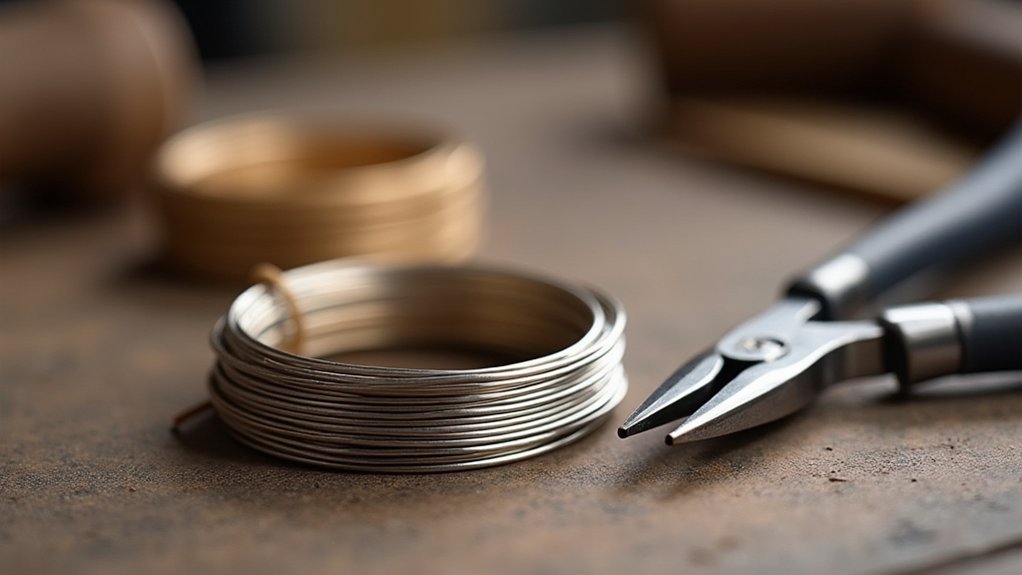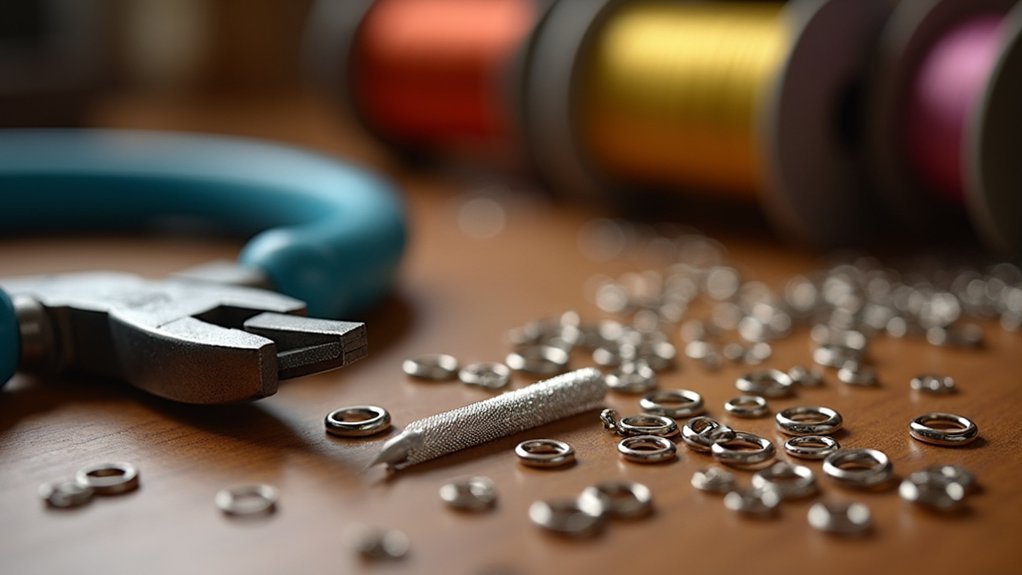You can make professional jump rings using three simple methods. First, wrap 18-gauge wire around a mandrel like a knitting needle, creating 5-10 tight coils, then cut with flush cutters at a slight angle. Second, use the BeadSmith Jump Ring Tool with a jewelry saw for precision cuts that don’t work-harden the metal. Third, hand-wrap wire with consistent tension, secure with pliers, and file smooth edges. These techniques will transform your jewelry-making projects.
Using Basic Wire Cutters and a Mandrel

Start your jump ring making journey with just two essential tools: basic wire cutters and a mandrel like a knitting needle.
Cut 18 gauge wire to 13 inches and attach it securely to your mm mandrel, leaving a small end for handling. Wrap tightly around the mandrel, creating 5-10 closely spaced coils for uniform handmade jump rings.
Remove the coil carefully and maintain its shape with your fingers. Use flush cut wire cutters to make jump rings using precise cutting techniques – trim the end just behind your first cut, angling slightly right for complete rings.
This jewelry making method guarantees quality jump rings every time. These essential tips and tricks create professional results with basic tools.
Creating Rings With the Beadsmith Jump Ring Tool and Jewelry Saw
Elevate your jump ring making with the BeadSmith Jump Ring Tool and jewelry saw combination for superior precision and quality. This method produces exceptional jump rings made from sterling silver or other metals, though you’ll get fewer rings than basic cutting methods.
Start by creating a wire coil around your desired inner diameter, then load it into the BeadSmith Jump Ring Tool with proper alignment.
Begin with a wire coil wrapped around your target inner diameter, then secure it in the BeadSmith Jump Ring Tool with correct positioning.
- Apply beeswax to your jewelry saw blade for smooth cutting and extended blade life
- Maintain consistent angles while cutting jump rings to prevent creating half circles
- Use nose pliers for adjustments if the coil drags during the cutting process
The jewelry saw won’t work harden the metal like wire cutters, resulting in superior quality rings when making jump rings professionally.
Hand-Wrapping Technique With Pliers and Filing

While the BeadSmith tool offers precision, you can achieve excellent results using basic hand tools and proper technique.
Begin by securing 18 gauge wire onto a mandrel, leaving 1.5cm for easier handling. Wrap tightly around the mandrel, maintaining consistent tension so your coil has closely spaced turns. This guarantees uniform jump rings for your wire jewelry projects.
After creating the desired coil, carefully remove it from the mandrel. Use flush cutters to trim, cutting slightly right for ideal formation. Make sure to inspect cut ends for sharp edges—use the flat cutter side to smooth rough spots.
Finally, use flat or round nose pliers for closing each ring. Adjust both ends carefully, making sure they fit snugly together for professional results.
Frequently Asked Questions
What Can I Use Instead of Jump Rings?
You can substitute twisted wire loops, beading thread, fishing line, decorative beads with large holes, leather strips, fabric loops, rubber bands, or silicone rings for traditional jump rings in your jewelry projects.
What Are Cheap Jump Rings Made Of?
You’ll find cheap jump rings are typically made from aluminum, plated copper, or steel. Aluminum’s lightweight and corrosion-resistant, while plated copper offers metallic appearance affordably. Steel provides durability but may need finishing.
What Wire to Use for Making Jump Rings?
You’ll want 18-gauge half-hard wire for the best jump rings. Copper, brass, or aluminum work well, with aluminum being lightweight and corrosion-resistant. Make certain your wire’s kink-free for clean cuts.
What Can I Use to Open and Close Jump Rings?
You’ll need two pairs of flat nose or chain nose pliers to open and close jump rings effectively. Grasp each side of the cut with the pliers, then twist sideways to maintain the ring’s shape.
In Summary
You’ve now learned three effective methods for creating jump rings, each with its own advantages. Whether you’re using basic wire cutters with a mandrel for quick results, the Beadsmith tool with a jewelry saw for precision, or the hand-wrapping technique with pliers for customization, you’ll be able to make professional-quality rings. Practice each method to determine which works best for your specific jewelry projects and skill level.





Leave a Reply